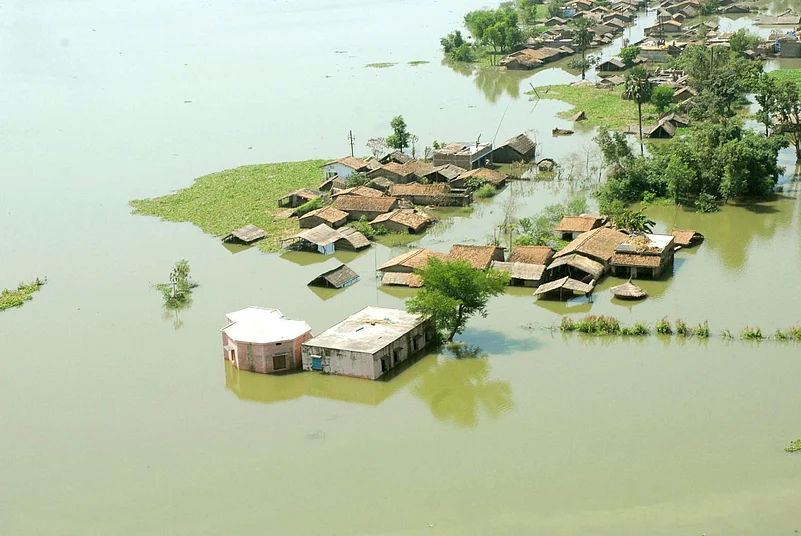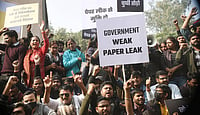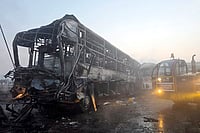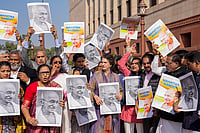
As per the Disaster Management Department of Bihar, between the 2020 elections and the present elections, nearly 30 million people across Bihar have experienced flooding
In 2020, over ten million people were affected across 19 districts and in 2025, nearly 4.7 million faced the deluge
As per the National Remote Sensing Centre’s Flood Hazard Atlas, 6.86 million hectares out of 9.41 million remain vulnerable to inundation
More than one crore jobs, emphasis on Extremely Backward Classes (EBCs), support for women and farmers, construction of the new ‘spiritual’ city of Sitapuram, infrastructure upgrade … the National Democratic Alliance’s (NDA) manifesto—Sankalp Patra—enlists the ruling coalition’s achievements and big-ticket plans for the future.
One, however, has to scroll all the way down—to page numbers 73 and 74 to be precise—to know what the government’s plan is to deal with the flood situation in the state—a recurring event that has been impacting lives and livelihood for decades. In the 80-page document, there is just one paragraph—under the sub-head: “Flood free Bihar in the Next Five Years”—that talks about the state’s flood management plan. It reads:
“We will establish flood management boards for Maithili and Kosi, including North Bihar, and quickly complete river linking projects, embankments, check dams, barrages, and canal construction under the “Dust Storm” model. We will conserve floodwater and use it for economic activities such as irrigation and fish farming. We will develop modern flood and other disaster warning systems by empowering the Bihar State Disaster Management Authority with modern technology, such as artificial intelligence, phones, satellites and sensors.”
The RJD-Congress-led Mahagathbandhan manifesto—Bihar Ka Tejashwi Prann—promises significant changes, including one government job per family within 20 days of forming the government, restoration of the Old Pension Scheme, Rs 2,500 monthly for women under the Mai-Behin Maan Yojana, alongside 200 units of free electricity. The 32-page manifesto at least acknowledges floods and droughts as Bihar’s defining crises but its vision remains largely rhetorical—broad in promise but thin on any immediate implementation.
While the overall tone of the manifesto is to present the elections as a historic opportunity to reclaim democracy and redefine Bihar’s governance, on Page 2, it accuses the NDA of betraying public trust and highlights baadh aur sukhha (floods and droughts) as enduring symbols of systemic neglect shaping the state’s economy and daily life. Later, on page 27, under the section titled “Water Resources, Flood-Drought Management, and Environmental Protection”, the manifesto outlines a broad vision for ecological renewal. It pledges to revive panchayat-level water bodies and create new reservoirs across regions, while prioritising the construction of pump canals along the Ganga, Gandak, Kamla, Kosi, and Mahananda rivers. The document acknowledges that enduring resilience depends on community-led and localised efforts, calling for the conservation of traditional water sources as a core strategy.
Floods have become Bihar’s most defining and unrelenting challenge, a cycle that year after year uproots millions, erodes livelihoods, and reshapes the landscape of survival. Between 2005 and 2025, spanning four Vidhan Sabhas from the 14 to the 17, around 133.88 million people have endured the fury of floods.
As per the Disaster Management Department of Bihar, between the 2020 elections and the present elections, nearly 30 million people across Bihar have experienced flooding, with 31 of its 38 districts submerged more than once.
In 2020, over ten million people were affected across 19 districts, and in 2025, nearly 4.7 million faced the deluge. North Bihar is one of the most flood-prone regions in the world, with around 73 per cent of its geographical area exposed. As per the National Remote Sensing Centre’s Flood Hazard Atlas (2020), 6.86 million hectares out of 9.41 million remain vulnerable to inundation. Marginal farmers, sharecroppers, and women-headed households bear the heaviest burden.
Between 2020 and 2025, floods have systematically undermined Bihar’s economic stability and agricultural productivity. According to the Bihar Economic Survey (2024-25), the state government allocated Rs 42,373 million for flood and cyclone management during 2021-22 to 2023-24, and Rs 1,128 million in 2024-25 (up to September 2024).
Expenditure on irrigation and flood control increased by 87.1 per cent in 2023-24, totalling Rs 73,820 million, with capital outlay rising from 38.9 per cent in 2019-20 to 79.6 per cent in 2023-24. Crop losses exceeding 33 per cent due to floods or hailstorms qualify for support under the Krishi Input Subsidy Scheme, providing Rs 17,000 per hectare for irrigated crops, Rs 8,500 for unirrigated crops, and Rs 22,500 for perennial crops.



























